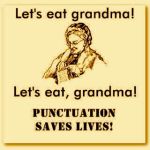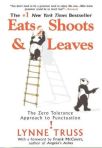What’s a comma between friends?
Susan Pierotti, Creative Text Solutions When you check for grammar mistakes, do you ever get confused when to use a comma? You’re not alone! Editors have huge chat sites devoted to just this topic. The rules on when to apply them are not clear-cut as American and English editing rules differ slightly. So why have them? Eats Shoots and Leaves This is the title of Lynne Truss’ book on punctuation. I recommend it for learning while laughing. The story is told of a panda which enters a restaurant, consumes a meal then guns down the waiter before it departs. When asked why it did it, the panda says to look up its definition in the dictionary: Eats, shoots and leaves.
The punchline only works because of the punctuation. The actual definition would really be “Eats shoots and leavesâ€, referring to its diet. Do you see how one comma made all the difference to the understanding of the sentence? Poor Grandma! Here’s another one: “Let’s eat Grandma.â€ Are we cannibals? No!
What we meant to write was:
“Let’s eat, Grandma.â€
Makes more sense – and Grandma is immensely relieved!
I don’t understand this!
Commas are like taking a breath when making a long speech. They help break up the sentence into understandable portions – what writers call the “flow†of a sentence.
“When dawn broke the man in order to have plenty of time to continue the editing and writing assignment began to check the spelling and grammar.â€
Was dawn breaking the man? Was it breaking the man in order to have plenty of time? Did dawn or the man check the grammar and spelling?
It may take you a few goes to read it correctly, but any repeat reading breaks the flow of the sentence, your concentration and possibly your interest. In other words, you stop reading it.
Is that what you want your clients to do with your copy?
So, here it is with a judicious comma or two:
“When dawn broke, the man, in order to have plenty of time to continue the editing and writing assignment, began to check the spelling and grammar.â€
It might look fussy but I bet you understood it better. And that’s what your customer will appreciate.
I’ve got a little list…
Try reading this:
“All children attending Music Camp will need a towel toiletries a week’s worth of clean clothes shoes an instrument a pencil rubber and sharpener and a music stand.â€
This shows you that you need commas for lists.
See how much easier it is to read with the commas:
“All children attending Music Camp will need a towel, toiletries, a week’s worth of clean clothes, shoes and one pair of boots, an instrument, a pencil, rubber and sharpener, and a music stand.â€
An even better version of the list is:
“All children attending Music Camp will need a towel; toiletries; a week’s worth of clean clothes, shoes and one pair of boots; an instrument; a pencil, rubber and sharpener; and a music stand.â€
Did you see what I did there? I added semicolons. That’s because the list has a number of items (pencil, rubber, sharpener) that should be grouped together but need a comma between them.
So how do you know when to use a semicolon? You’ll have to read my next blog for that!
The services of a professional proofreading and copyediting service will assist you with accurate and comprehensible punctuation. Contact www.creativetext.com.au for further assistance.
Are we cannibals? No!
What we meant to write was:
“Let’s eat, Grandma.â€
Makes more sense – and Grandma is immensely relieved!
I don’t understand this!
Commas are like taking a breath when making a long speech. They help break up the sentence into understandable portions – what writers call the “flow†of a sentence.
“When dawn broke the man in order to have plenty of time to continue the editing and writing assignment began to check the spelling and grammar.â€
Was dawn breaking the man? Was it breaking the man in order to have plenty of time? Did dawn or the man check the grammar and spelling?
It may take you a few goes to read it correctly, but any repeat reading breaks the flow of the sentence, your concentration and possibly your interest. In other words, you stop reading it.
Is that what you want your clients to do with your copy?
So, here it is with a judicious comma or two:
“When dawn broke, the man, in order to have plenty of time to continue the editing and writing assignment, began to check the spelling and grammar.â€
It might look fussy but I bet you understood it better. And that’s what your customer will appreciate.
I’ve got a little list…
Try reading this:
“All children attending Music Camp will need a towel toiletries a week’s worth of clean clothes shoes an instrument a pencil rubber and sharpener and a music stand.â€
This shows you that you need commas for lists.
See how much easier it is to read with the commas:
“All children attending Music Camp will need a towel, toiletries, a week’s worth of clean clothes, shoes and one pair of boots, an instrument, a pencil, rubber and sharpener, and a music stand.â€
An even better version of the list is:
“All children attending Music Camp will need a towel; toiletries; a week’s worth of clean clothes, shoes and one pair of boots; an instrument; a pencil, rubber and sharpener; and a music stand.â€
Did you see what I did there? I added semicolons. That’s because the list has a number of items (pencil, rubber, sharpener) that should be grouped together but need a comma between them.
So how do you know when to use a semicolon? You’ll have to read my next blog for that!
The services of a professional proofreading and copyediting service will assist you with accurate and comprehensible punctuation. Contact www.creativetext.com.au for further assistance. 


